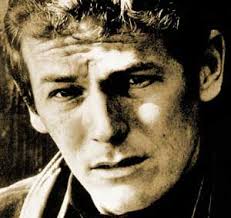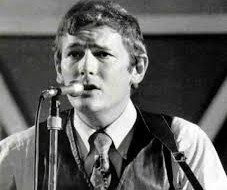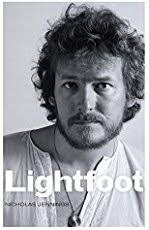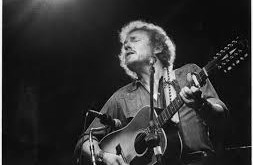There was a time in this fair land when the railroad did not run
When the wild majestic mountains stood alone against the sun
Long before the white man and long before the wheel
When the green dark forest was too silent to be real
— Canadian Railroad Trilogy
If you could read my mind love
What a tale my thoughts could tell
Just like an old time movie
About a ghost from a wishing well
In a castle dark or a fortress strong
With chains upon my feet
You know that ghost is me
And I will never be set free
As long as I’m a ghost you can see
— If You Could Read my Mind
I had a thing for Gords when I was a kid.
Gordie Howe, the great Detroit Red Wings right winger who became known as Mr Hockey, was my first hero. I was four years old and the Red Wings have been my professional hockey team of choice ever since, spanning six decades
Gordon Lightfoot — a Triple Crown singer/songwriter in a talented stable of musical thoroughbreds including Neil Young, Joni Mitchell, Robbie Robertson, Leonard Cohen, Bruce Cockburn, Stan Rogers and Ian & Sylvia Tyson) — was my second hero. I was 16 and he had as much to do with who I eventually became as any figure who ever ignited my imagination.
I was in Grade 10 at H. B. Beal in 1967 when my English teacher, Larry McGuire, introduced the class to Lightfoot’s eponymous debut album released a year earlier. He also introduced us to Leonard Cohen. Great teacher. Unbelievable!
My ears stood at attention on hearing the opening bars of the first track Rich Man’s Spiritual. By the last bars of the final track, Peaceful Waters, I was hooked. In between were Long River, The Way I Feel, For Lovin’ Me, Steel Rail Blues, I’m Not Sayin’, Ribbon of Darkness and the great Early Mornin’ Rain, among others. It was the first album I ever bought. I’ve purchased hundreds since then, including all of Lightfoot’s studio releases.
That year CBC TV aired a Centennial variety program in which Lightfoot stole the spotlight (he wrote his classic Canadian Railroad Trilogy especially for the show). For Christmas I asked for an acoustic guitar. Instead, a ukulele greeted me from under the festive evergreen. Talk about lunchbox letdown.
Disappointed but not discouraged, I bought an Echo guitar as soon as I could save enough money from my minimum wage and undeclared tips as a bellhop at the Hotel London, located in the heart of downtown in my hometown of London. I bought the instrument around the corner at Chapman & Hewitt — the music store where Lightfoot purchased his guitar strings when he performed at the long-gone Brass Rail Tavern, located on Dundas Street in what was then known as London East. (In his wonderful memoir Testimony, Robbie Robertson remembers the tavern ‘as the nicest place in town to hear rock ‘n’ roll music.’ It’s where he made his Canadian debut with Ronnie Hawkins and the Hawks.)
I recall Lightfoot’s sister Bev working in the bank just down the street from the hotel on Dundas St., where I cashed my weekly paycheque. I remember asking her once if she was related to the folksinger.
My cousin Alan, whose family lived across the street from mine in London West, had been taking guitar lessons from Eddy Bell, a well-known local jazz musician. I followed his lead and after a few formal lessons, I brought in my Lightfoot songbooks and Eddy began teaching me how to fingerpick. By the time I went off to Trent University in 1972 I could fingerpick and double-strum Lightfoot style every song he had recorded on his first five albums.
Until I sold my last guitar to finance a fly fishing trip to the West Branch of the Ausable River in the Adirondacks, I was still using the same fingerpicking technique — 50 years later.
Through my teen years and early 20s I eagerly awaited every Lightfoot release: Lightfoot (1966), The Way I Feel (1967), Did She Mention My Name and Back Here on Earth (1968), Sunday Concert (1969), Sit Down Young Stranger [later released as If You Could Read My Mind] (1970), Summer Side of Life (1971), Don Quixote and Old Dan’s Records (1972).
After buying the vinyl album I would pick up a bottle of London Winery’s XXX Sherry (real rot-gut) at the LCBO and a ‘two-four’ of Molson Export at the Beer Store before heading over to my Uncle Jim’s (my dad’s second youngest brother) who lived next door. With a sense of secular reverence we would listen to the new album over and over and over again, all through the night and into the early daylight hours of the next day. (BTW, although the legal drinking age was 21, I started buying booze when I was 16 without ever being asked for ID.)
When I could play guitar, I would regale my uncle with Lightfoot songs, over and over and over again. I eventually taught him to play guitar. We faithfully followed this ritual of homage until I went to university.
I studied English at university in part because I thought that someday I might write a Lightfoot bio. Ottawa writer Maynard Collins beat me to the literary punch with If You Could Read My Mind in 1988; but it was so bad I wasn’t worried. I’ve always thought the photo of Lightfoot on the cover was taken after he’d read a draft of the book — he looks royally pissed. Moreover Collins’ bio ended when Lightfoot was 50; there was a lot of living, not to mention nearly dying, still to come.
The years went by. I conducted interviews, wrote features and reviewed concerts as an arts & entertainment reporter at the Waterloo Region Record for three decades beginning in 1986; but I never got around to writing the life story of the artist who set me on the creative path that comprised my professional life.
Interviewing Lightfoot was often painful. Confiding to strangers was difficult for him. He seemingly had little interest in answering questions; he tended to fall back on banal, fragmented sentences that veered close to the precipice of incoherence. This wasn’t necessarily willful rudeness on his part; once prior to a concert at Centre in the Square his management company called me to see if I was interested in interviewing the artist (see feature below). He really did care, but his crippling shyness and intense modesty were pathological. He might have left Stephen Leacock’s Orillia, but the small Ontario town never left him.
What I might have written has been rendered inconsequential by Canadian music journalist Nicholas Jennings and his fine new bio Lightfoot. It’s likely to remain the definitive biography because of Jennings’ access to the famously reticent artist and to the people who know him best.
The bio is straight-up journalism. It traces the singer/songwriter’s childhood through a professional career that began in Toronto’s Yorkville in the Swinging 60s. Jennings, a music critic and feature writer for Maclean’s magazine from 1980 to 2000 and author of Before the Gold Rush, isn’t a flashy writer; there are few flights of poetic fancy.
Nonetheless, he paints a full portrait of the artist, warts and all, including bad concert behaviour fuelled by heavy drinking (Lightfoot is a reformed alcoholic), serial infidelities, neglect of the significant women in his life and his absence in the lives of his children for many years. These darker hues are balanced by the lighter hues of Lightfoot’s blue-collar work ethic, which he maintained even as fame brought him increasing wealth; his steadfast loyalty; his deep love of nature which inspired his music and encouraged his environmental activism; and his compassionate devotion to social causes.
Lightfoot emerges has a man and an artist who faced demons as he struggled mightily with guilt and regret on the path toward redemption and atonement.
Although Jennings’ does an admirable job documenting Lightfoot’s music, there isn’t much in the way of analysis beyond a sentence or two on the origins of individual songs. I would have liked more interpretation and evaluation, but I acknowledge that Lightfoot is a more accessible songwriter than a Bob Dylan, Robertson or Cohen, to name three examples.
I eagerly anticipated the release of this bio and I was not disappointed. I recommend it to Lightfoot fans, as well as to anyone with even a passing interest in Canadian music.
Here’s Jennings’ succinct summation of what Lightfoot means to Canada:
In Canada, Lightfoot’s status has grown to mythic proportions. No other work by a cultural figure has become so intrinsically linked with Canadian history, landscape and nationhood than has Lightfoot and his songs. Whether capturing the majesty of Canada’s outdoors, the thrill of the Rockies, the breathtaking power of the Great Lakes or ‘the teardrops and the toil’ of building ‘the iron road runnin’ from the sea to the sea,’ his music is pure Canadiana. With a painter’s eye for landscape and a poet’s taste for romance and a historians’ allegiance to accuracy, Lightfoot has inspired comparisons to Canadian icons Emily Carr, Pierre Berton and the Group of Seven, But is indelible melodies and vivid storytelling have made him, perhaps, the most Canadian icon of all.
I agree with Jennings’ assessment, with the one caveat that I would compare Lightfoot more to Tom Thomson than to Carr, Berton or the Group of Seven.
I would now like to recall some random thoughts and fleeting observations about Lightfoot expressed through the years. Initially identified as a folksinger on the margins of the American folk revival of the 1960s, Lightfoot is more accurately viewed as a member of the first generation of modern singer/songwriters who never completely turned his back on the folk tradition of historical narrative.
More a personal songwriter than a confessional songwriter — he’s much too shy, modest and insecure to expose himself publicly — few writers have composed so many eloquent songs that dig so deeply into the mind, heart, imagination and soul of Canada. Along with a handful of visual artists and poets, Lightfoot’s relationship to the country in which he was born, and where he’s lived his storied life, is mythic in thrust.
I’ve seen Lightfoot in concert as much as I’ve seen any other recording artist, as both a fan and as an arts reporter: first at Alumni Hall at Western University multiple times, then at the venerable Massey Hall, later at Peterborough’s Memorial Centre and finally at Kitchener’s Centre in the Square multiple times.
Seeing Lightfoot in concert has proven paradoxical. In the early days he seemed disinterested in performing live. After the illness that nearly snatched his life, he came to ‘need’ performing, even in vastly diminished capacity. His most loyal fans have not wavered in their devotion, which is a tribute to the iconic artist.
Truth is, I wish he had retired from performing live at least a decade ago, even if fans won’t hear of it. It was painfully sad to see how perfunctorily he was handled by CBC TV during the national variety show broadcast on July 1 in honour of Canada’s sesquicentennial. After his performance of If You Could Read My Mind, I wrote these few lines:
Strands of long grey hair,
a face chiseled from the contours of Canadian Shield,
fragile but strong as our Native land,
Gordon Lightfoot,
a living ghost
haunting, still,
reading our collective mind,
carving mythology from the geography of memory,
singing songs of our home place
— embodiment of Canada, now and always.
Following are excerpts from two Centre in the Square concert reviews and an interview I conducted while covering arts & entertainment for The Record:
11 November 1993 Concert
Gordon Lightfoot’s chiselled profile and sinewy frame brings to mind Tom Thomson’s paintings. Both are quintessentially Canadian in ways that defy the many insidious forces bent on tearing this country apart.
Lightfoot made his irregularly regular visit. . . (he was last here for the Centre’s 10th anniversary just over three years ago) and delighted the near-capacity crowd with a repertoire spanning 30 years, ranging from the classic Early Mornin’ Rain to a comprehensive sampling from Waiting for You, his 18th original recording since his self-titled debut in 1965.
Lightfoot canoes with a group of Kitchener businessmen and the presence of some of them in the audience, coupled with friends he has made over the years, made for a warm reception from a crowd on intimate terms with his music.
After two polished 55-minute sets, brimming with 26 songs (including Cotton Jenny and Sundown, in addition to Restless, Wild Strawberries, Fading Away, the title track and ‘Mr. Dylan’s Ring Them Bells‘ from the latest release), Lightfoot responded to a standing ovation with a double encore, featuring Old Dan’s Records and Don Quixote.
Although he obviously enjoyed himself with a handful of what he referred to as ‘toe-tappers,’ the concert reconfirmed the artist as one of the great ‘folk’ balladeers to emerge since the Second World War.
Lovely new ballads such as Only Love Would Know and his new single I’ll Prove My Love (which he wryly introduced as ‘one of the better-known secrets of the showbiz industry these days’) hold their own beside such classics as Song for a Winter’s Night (actually composed during a rainstorm in Cleveland), If You Could Read My Mind (one of the best pop songs of the last 25 years), Beautiful (yes, it has stood the test of time) and the poignant Shadows (which has to do ‘with nature and some of the other things in life’).
As usual Lightfoot wan’t big on between-song banter, however his humour permeated the concert. At one point, he introduced a song with a riddle and on a few occasions he referred to the rowdy drinking days of yore.
The performer sounds better now than he did at any time in the past 15 years. Especially in the second set, after his weathered pipes warmed up, he recaptured some of the lush timbre we associate with Lightfoot of the 1970s.
As always, his touring band of many years — Terry Clements on lead guitar, Rick Haynes on bass, Mike Heffernan on keyboards and Barry Keane on drums — provided just the right hues to fill out the musical palette.
One of the signature elements of Lightfoot’s live performance is the consistency of the format, which has not altered dramatically since the early 70s. Standing stage centre, flanked by his sidemen, switching between his Martin six-string and sunburst Gibson 12-string and punctuating his songs with an appreciative nod or an awkward thank-you, remain as constant as the Canadian Shield.
An added flourish, however, occurs in the second set when Lightfoot sits and reads hastily written requests. He honoured a couple, while refusing For Lovin’ Me as apparently too chauvinistic. His encores provoked a wild cacophony of shouted requests from fans throughout the auditorium.
He ended his first set with the penultimate Wreck of the Edmund Fitzgerald (‘a modern-day Flying Dutchman’). He concluded the concert with Canadian Railroad Trilogy (described as his ‘big song’ and ‘crowd-pleaser’). Introducing the former, Lightfoot pointed out that the Great Lakes’ vessel went down 18 years ago.
Indeed November is the month of anniversaries for the beloved singer/songwriter who celebrates his 54th birthday November 27. For an artist who has left us more than three songs for each of his 54 years — and still counting — birthday greetings seem insignificant expressions of gratitude. But, what the hell, Happy Birthday Gord. And thanks.
November 1993 Interview
(Note: I found Lightfoot unusually open and expansive during this interview)
It’s easy to take Gordon Lightfoot for granted, to dismiss a legend, to ignore an icon.
Once regaled as Canada’s most popular troubadour, his shine tarnished when personal foibles and a waning career conspired against the kid from Orillia with a golden tenor-turned-baritone voice and a facility for wapping memorable melodies around eloquent words.
But rumours of the singer/songwriter’s demise after three decades in the spotlight — circulated for a time by the artist himself — have proven not only exaggerated, but premature. Authentic legends, as opposed to pop flavours of the month, are as durable as the Canadian Shield.
Waiting for You heralds the return of an artist whose accomplishments encompass platinum and gold records, four Grammy nominations, an amazing 16 Junos including induction into the Juno Hall of Fame, an Order of Canada citation and honorary degree from Trent University (my alma mater).
Waiting for You is Lightfoot’s first collection of new material since East of Midnight, a recording released amid claims that it would be his last. ‘I felt like I’d said everything I wanted to,’ the artist said at the time. ‘I didn’t want to keep writing songs if they didn’t have meaning for me.’
Nonetheless, the title of East of Midnight proved prophetic. It was after the 1986 release that he reassessed his life, his career and the music that was their product. The joy he found with the birth of his son Miles and the happiness he found with his wife Elizabeth (he dedicates Waiting for You to both) began informing his songs. With renewed creative energy he began working on new material, songs written over a two-year period which he agrees are the most personal he has ever written.
Nine of the ten songs (his cover of Dylan’s Ring Them Bells rounds out the collection) chronicle an artist coming to terms with himself and his place in the scheme of things. The humour, sense of self-acceptance and new-found contentment are reflected in his comments during a telephone conversation from his Rosedale home. ‘Let me put it this way, I had to dig deep,’ the 54-year-old performer observed. ‘The older you get, the deeper you have to dig.’
The product of Lightfoot’s midlife soul-searching is music as buoyant and optimistic as he has ever produced. ‘I like to feel it has an uplifting quality. At times my music has not been as uplifting as it should have been and I feel I’ve been able to achieve that again.’
Stylistically the album marks a return to a more direct and immediate Lightfoot. With prominent voice and acoustic guitar tracks and unembellished arrangements with his longtime touring band, the recording shares more in common with his early classics than with the work he released in the late 1970s and throughout the 80s.
‘We achieved a lot with East of Midnight (produced by Lightfoot and including Anything for Love, a song co-written and co-produced with David Foster), but it didn’t get the airplay we wanted,’ he admitted, barely concealing his long-standing frustration over lack of radio support. ‘So I said this time, after taking a look at the way the market is today and not wanting to go in a country direction, that we’ll bring things around and use our own guys (rather than studio musicians) as he had in 1988 with Gord’s Gold Vol. II.
Lightfoot is so pleased with his approach to Waiting for You that he wants to refine it for subsequent recordings. ‘If I can make another one, which I hope I can, I’d like to try the same formula with just a little more enhancement and more work on the basic tracks,’ the notorious perfectionist asserted. ‘I think that way we might get some acceptance on radio,’ he speculated, returning momentarily to scratch a persistent itch. ‘But if we don’t get radio acceptance, we still have our concert audience and our recording contract.’
The past couple of years have been gratifying for Lightfoot fans, beginning with the release of The Original Lightfoot, a three-CD compilation of the first five albums recorded on United Artists. Performers customarily have ambivalent opinions about their early work and Lightfoot is no exception. Still, he feels most of the material holds up pretty well (even if the release by his former label annoys him).
‘It’s pretty much agreed that the material is out there in the public domain,’ he notes diplomatically. ‘and having presented it with the biography and packaged the way it was and sounding the way it does, we’re very pleased with it.’
The question of whether he wanted the material released leads to some additional comments. ‘I suppose everybody has stuff around that they don’t want out there and I have some of that stuff, too,’ he concedes with a chuckle. ‘The time I made those albums I was managed by a prominent manager stateside (Albert Grossman, manager of Dylan, The Band, Janis Joplin, Ian & Sylvia and Peter, Paul & Mary) and I was getting a lot of activity on my songwriting. The albums were done sort of to keep track of everything.’
Private, almost reclusive by nature, Lightfoot’s career arc is well documented. The product of Toronto’s folk community in the 1960s, along with the likes of Ian & Sylvia, Joni Mitchell and Neil Young, his career developed just as the Brits invaded North America via Sunday night’s Ed Sullivan Show. While musical fashion embraced such fads and fetishes as psychedelic, disco and punk, Lightfoot for the most part stayed the acoustic course.
For the first time since the early days of his career, public taste has intersected with his music. ‘The likes of Eric Clapton and Rod Stewart playing up the acoustic idea is interesting,’ he acknowledged with a chuckle, ‘I guess you could say we’ve always been that way.
Always the consummate professional, Lightfoot has re-dedicated himself to his craft by attentively caring to the details which are the hallmark of professionalism. ‘We’ve been working on our sound a lot, and I think we sound better on stage than we ever have. I’m really proud of that.’
The same commitment to quality extends to the rehearsal hall. Although Waiting for You was recorded over a couple of days, extensive preparation went into the release. ‘There was a lot of rehearsing that went into it. All the charts were written — I write all the charts myself — and all the parts had to be worked out. It took months.’
Although Lightfoot has toured and recorded with the same small handful of musicians since the beginning (including bassist John Stockfish and lead guitarists David Rae and Red Shea), he retains a firm grip on creative control. ‘A song has to be finished (before going into rehearsal). You might have to change something here or there in the lyrics, but the song’s format has to be nailed down.’
Lightfoot is working on three songs in progress. None are concert ready. ‘The problem is, I don’t like to burden audiences with them. I know people like to hear new stuff, but there’s never enough time.’
What he’s referring to, albeit obliquely, is the playlist of personal favourites fans come to concerts expecting to hear. ‘I probably won’t do anything brand new; yet, it’s so damn exciting, isn’t it?’
The question, expressed with such unbridled enthusiasm, heralds a Gordon Lightfoot well worth waiting for.
11 November 1996 Concert
Standing centre stage in the spotlight with guitar in hand, Gordon Lightfoot strikes a profile as though chiseled out of the Canadian Shield. For, more than any other Canadian musician, he is associated with the landscape of this country — its grandeur, vastness, loneliness, yearning, poetry and spirit.
In a career spanning more than three decades, it’s easy to forget how Lightfoot helped shape the course of acoustic-based pop music, not only in Canada, but across North America and the world beyond.
Emerging in the 1960s (remember Yorkville’s Riverboat?), Lightfoot was one of the first artists to make the transition — maybe transformation is the more accurate word — from folksinger to singer/songwriter, joining such artists as James Taylor, Carol King, Don McLean and Simon & Garfunkel. Dylan (always a singer/songwriter) made a comparable transformation from folk to rock (with help from Robertson and The Band).
Straddling the borders of folk, country and pop, Lightfoot at his best has always written emotionally rich songs with the careful, unpretentious and meticulous skill of a master craftsman. His poetic lyrics are seamlessly welded to pleasing melodies that linger in the ear.
Although many of his more than 400 songs have been recorded by a veritable Who’s Who of contemporary music, Lightfoot’s own weathered baritone and nimble guitarwork remain the most eloquent tools for expressing such enduring classics as Early Mornin’ Rain, Canadian Railroad Trilogy, If You Could Read My Mind and The Wreck of the Edmund Fitzgerald — to name only a few of the songs that are etched into the fabric of this country’s collective psyche, heart and soul.
Lightfoot, however, is not one to rest on his laurels or accolades, despite the handsome royalties, gold and platinum records, Grammy nominations, Juno Awards, honorary degrees and Order of Canada citations. He’s too small-town Canadian for that.
With his 59th birthday days away, he introduced a half dozen new songs earmarked for a new album with a projected spring release date. From a touching tune about an unexpected encounter with a faded country singer, to a ditty written in his boathouse on Lake Rosseau, the new songs are an extension of the material on Waiting for You.
One of the more interesting new songs is the autobiographical A Painter Passing Through. Wonder if the title owes anything to his old friend, the late painter Robert Markle? Perhaps not, since Lightfoot has always been a painter with words and melodies.
Waiting for You was well represented with Restless, Fading Away and I’ll Prove My Love, in addition to the title track. But the demonstrably partisan crowd saved its most enthusiastic receptions for old favourites, such as Carefree Highway, Sundown and The Wreck of the Edmund Fitzgerald during the first of two 60-minute sets.
The highlight of the opening set, however, was a delightful surprise that rekindled memories of one of Lightfoot’s best albums, Sit Down Young Stranger (later changed to If You Could Read My Mind). Wearing a poppy in his shirt, he paid tribute to Remembrance Day with the album’s original title track, an oft-requested but seldom-performed coming-of-age, anti-war, protest song he wrote during the Vietnam War. Unlike the in-your-face Black Day in July (about the Detroit Riot of 1967), the ballad is subtle and suggestive rather than explicit.
Alternately standing and sitting on a piano bench during the second set, Lightfoot made his way through some of his finest songs including Don Quixote, If You Could Read My Mind, Beautiful and Early Mornin’ Rain.
Although the crowd wanted more, the artist expressed his gratitude with a single encore number. As usual, it was the last song of the second set that fans left the auditorium with clearest in their minds and warmest in their hearts.
At just over six minutes in length, Canadian Railroad Trilogy is one of this country’s defining artistic statements. Equal parts history, topographical map, social documentary, poem, anthem and prayer, it is mythic in scope, reach and depth. All anyone who doubts the emotional power of this haunting masterwork need do is honour the reverential silence that befalls the auditorium as Lightfoot sings:
‘When the green dark forest was to silent to be real/And many are the dead men. . . (extended silence as we hear a pin of thanksgiving drop). . . to silent to be real.‘
Lightfoot in his prime performing his masterpiece Canadian Railroad Trilogy on BBC in 1972 (with Haynes on bass and Shea on lead guitar):
The Lightfoot Discography is comprised of 19 studio albums, three live albums, 16 greatest hits compilations and 46 singles.






